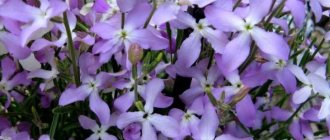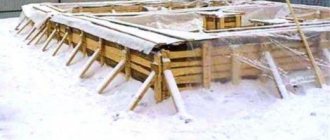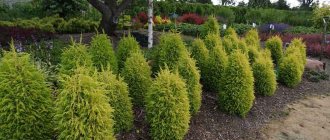When buying ornamental grasses, we often fall for their unpretentiousness, believing that there will definitely be no fuss with them. In the first summer of planting, they actively grow and develop, delighting the owners, but next spring they may not turn green.
This is due to the fact that all the inflexibility of cereals is explained by the type of soil, watering and fertilizer, but many of these herbaceous plants react extremely negatively to frost. Ornamental grasses with the most striking appearance are often natives of hot countries, and their “wintering” mechanism is simply not provided by nature.
But you shouldn’t give up growing these lush bushes with interesting colors; you just need to choose those cereals that are bred and adapted to regions with a similar climate and are characterized by increased winter hardiness.
We have already advised which ornamental grasses and grains are suitable for the northern regions; today we will talk about those representatives that will feel better in a plot in the middle zone (climate zone 5-6).
Arundo reed (giant reed)
It’s not for nothing that the second name for reed arundo is giant. The stems of this cereal with linear-lanceolate leaves can grow 4-6 m in height, and long rhizomes very actively “develop” the soil. If you decide to have this plant in your garden, remember that it is extremely aggressive and fast-growing and requires restrictions on the territory.
Arundo prefers sunny, damp places (an area near a pond is quite suitable). It blooms in autumn with thick lush panicles, requires spring pruning to a height of no more than 10 cm and shelter for the winter.
The varieties Variegata and Versicolor are most often cultivated for decorative purposes - the first has leaves with longitudinal wide white stripes, and the second has bright yellow-green leaves.
Lightning blue
Blue lightning is another tall grass with glaucous leaves and blue-violet panicles. It also needs moisture, planted together with flowers with a similar growth regime, or decorates the edges of artificial ponds.
Planting trees on the siteKerria or Keria: photo and description of the shrub, rules and subtleties of growing a plant with yellow flowers
Ornamental shrubs in landscape design blooming in autumn
The Miscanthus family deserves special attention. These giant-sized cereals with an erect stem have many varieties that differ in color and shape. This light-loving and moisture-loving plant, with a height of 80 cm to 3 m, needs protection from frost.
Used in mixborders, for decorating ponds, luxurious bushes of Chinese and sucrose miscanthus can become an exquisite decoration of green lawns.
Veynik
Huge reed bushes can be found all over the world. Its height reaches a meter, so it is perfect for the role of a tapeworm or a vertical part in a group planting. Used in borders and hedges. In summer, the stems and spikelets of reed grass are green; by autumn they partially turn yellow, and in winter, covered with frost, they become pearly and continue to decorate the garden.
The most popular varieties of reed grass: Avalanche, Waldenbush, Karl Forster, Overdam.
Reed grass is propagated by dividing the bush, in May, every 5-7 years. If this is not done, the bush will outgrow and become disproportionate. It grows well in any soil, but if you give it a sunny and fertile area, it will become the pride of your garden in a couple of years.
Imperata cylindrical
Although imperata is native to the tropics, this perennial grass has adapted well to our climate zone. This moderately moisture-loving plant prefers full sun, but can also grow in partial shade. Well-drained soil is preferable for it.
The thick, dense bases of imperata quickly crowd out other vegetation in the vicinity.
Most often in gardens you can find the Imperata variety Red Baron, whose leaves at a young age are bright green with crimson-red tips, and as they grow they actively turn red along their entire length, becoming blood-red by autumn. Against the background of foliage of such a rich color, silvery fluffy spikelets look gentle.
Hydrophyte plant
Lake reed is a hydrophyte - plants of coastal waters and swamps that lack moisture. Their roots are in viscous heavy silt, where there is almost no oxygen. Hydrophytes would be doomed to death if they did not have special adaptations. The fact is that the roots of such plants receive the oxygen necessary for respiration not through the soil surface, but through aerenchyma - a special air-bearing tissue.
In lake reeds, on a cross section of the stem, behind the outer cells you can see air passages - voids separated by films, which represent a network of narrow cells connected in chains. These chains converge and form aerenchyma - air-conducting bundles. There is always air in the tissues of such bundles. It has been proven that the oxygen concentration is disturbed by mechanical damage to the stem, and this suggests that the marsh plant saturates the intercellular air with oxygen on its own: it is absorbed by green chlorophyll-bearing tissue during photosynthesis.
Since air-conducting bundles are present not only in the stem, but also in the rhizome, oxygen freely flows to the roots, and reaches the most distant underground organs, flooded with water and buried deep in the silt. Thus, thanks to aerenchyma, lake reeds receive a sufficient amount of oxygen for breathing.
Feather grass
This genus of short-rhizome perennial grasses includes more than 300 species, many of which are suitable for decorative plantings on the site. Several types of feather grass are suitable for middle latitudes - feathery, thin and shiny, which differ in the timing of flowering, as well as the color and width of the foliage.
All of them are light-loving, frost- and drought-resistant, and love dry, non-acidic, well-drained soils. Feather grass is a slow-growing plant, but very durable and unpretentious, capable of turning your site into a real steppe, swaying in the wind. They reproduce by seeds and by dividing the bush; the leaves of the feather grass are cut off in the spring, and the flower stalks in the fall.
Mace Bearer
The dense, seemingly bristling bushes of the gray macebearer are ideal for decorating borders 20-30 cm high. This light-loving and fast-growing ground cover plant takes root well in sandy soils of the middle zone.
- Indoor ventilation
Choosing grass for the lawn
Deutzia is blooming - summer is coming
Keleria (thin-legged) gray
This genus of perennial herbs with narrow-linear leaf blades grows to only 30-40 cm in height. But its dense turf with silver-blue leaves looks very elegant in the garden. Keleria blooms in June-July with cylindrical spike-shaped panicles.
Thin-legged gray looks beautiful on rocky hills and rockeries, tolerates cold winters well, but needs additional drainage and loves the sun very much. Propagated by seeds and dividing the bush, requires pruning in March-April.
Kolosnyak
It will look good as a single bush or as a border. Goes well with lilies. It is painted gray and retains its shape well. The disadvantage is its rapid growth, which can be combated by fencing the grass with slate or planting it in a container without a bottom.
Miscanthus
The green “fountains” of miscanthus are good in themselves, and during flowering, their pink or silver panicles attract all eyes. Depending on the variety, the plant can reach from 0.8 m to 2 m in height, and with age it can grow up to 2 m in diameter.
The most popular miscanthus varieties: Little Kitten, Yaku Jima, Adagio, Kleine Silberspinne (compact), Kleine Fontäne, Ferner Osten, China, Flamingo (medium), Goliath, Grosse Fontäne, Professor Richard Hansen, Rotfuchs (large).
All miscanthus love water and sun, so if you want to grow a large, lush grass, do not forget to water the plant and give it a place on the sunny side of the site. Active growth of miscanthus can become a problem for its neighbors in the flower bed, so either plant it in privacy or dig a border tape around the roots to a depth of at least 30 cm.
- Miscanthus - a grass for a garden in the Provence style
Cereals can decorate the garden no worse than beautiful flowering plants. Miscanthus is a clear confirmation of this.
Application in landscape design
There are several options for using ornamental grasses. Firstly, they are planted as a complement to more striking representatives of the fauna and emphasize their majesty. In this design, they provide volume to the composition and fill empty space. Low-key green-leaved plants with dense foliage are suitable for this.
Cereals in composition with conifers
Secondly, cereals themselves can be the dominant feature of the garden. But for this you need to select species with an attractive appearance: with lush panicles, variegated foliage, and an unusual rosette shape. The plants chosen as the basis are planted in a group on a green lawn, and the rest of the vegetation is located at some distance from the central part of the composition.
Pampas grass as a dominant feature in the composition
The most interesting idea with ornamental grasses is an herb garden. Several species of plants with different habitus and texture are collected in it and planted in small groups. Each species is assigned a strictly delineated territory to prevent their mixing. The garden is compiled in different ways: according to the principle of a mixborder, a ridge, or in another order.
Flower of decorative herbs
Mixborder with cereals
Advice. The herb garden is a fairly complex project and takes several years to complete. It can begin with a mixed flower garden, in which garden crops are gradually replaced by herbs.
Cereals and herbs are excellent materials for decorating alpine slides and rockeries. They look natural among stones, and their root system is well adapted to development on difficult soils. Most grains thrive in cramped conditions, so they are often used as container crops.
Rockery with cereals
Molinia
Until recently, this unpretentious ornamental grass was more often found in swamps than in garden plots, but now designers appreciate it. The modest plant requires minimal care only in the first two seasons, and then remains attractive for decades without your intervention.
The easiest way to grow is blue molinia, but if you want maximum splendor and bright colors, you should pay attention to reed molinia and varieties such as Bergfreund, Fontane, Staefa.
Molinia is propagated by dividing the bush, care is reduced to watering during dry periods, and it can cope with weeds on its own. Lightning wakes up late, so don’t rush to trim old leaves in the spring.
How to grow
It is easy to get confused among the many names of ornamental grass. However, you need to know for sure whether it is suitable for your climatic conditions. They may need to be covered for the winter. After all, many species were brought from tropical and subtropical countries, where winters are much warmer than in the central zone, and even more so to the north. Usually all the required information is written on the packaging.
With proper care, the climate should not create any problems.
There are unpretentious varieties that should not be sown directly into the garden. First, this ornamental grass in pots must get stronger, and then it can be planted. Otherwise, large plants can drown it out. Some species can be planted not only from seeds, but also by dividing the roots.
Cold-resistant varieties are characterized by early growth after the snow melts. If transplantation or seating is required, it is worth carrying out these procedures in early spring or in September-October. An important condition is the air temperature is no more than +20 Celsius.
Muhlenbergia hairy (deer grass)
Muhlenbergia is a warm-growing herbaceous perennial native to North America. In our latitudes it forms curtains from half a meter to a meter in height and width. Its leaves are needle-shaped - very narrow and hard. Dark green in summer, by autumn they acquire a bronze or copper tint and retain this color for a long time in winter. The plant blooms in August-September with very fluffy pinkish panicles, which then become purple, and even later – light brownish.
Muhlenbergia prefers slightly acidic loose soils, sunny or semi-shaded places, and is otherwise extremely unpretentious. It only does not tolerate severe frosts and requires shelter for the winter. Propagated by seeds or dividing the bush, needs spring pruning.
About cattails for children
Throughout Russia, in shallow waters, shallows, and the banks of reservoirs, you can see thickets of thin plants with black velvety cones and narrow leaves. This plant is called reed or reed. It's actually neither, it's a cattail.
The fabric that was woven from the stems of this plant was also called cattail. Rough fabric is still called matting.
Cattail is a perennial plant with a stem 80-300 cm tall and a thick branched rhizome. The leaves, up to 1 cm wide, are longer than the stem, can withstand strong winds due to their helical twist, and have up to 20 air vessels with partitions visible to the naked eye.
The most remarkable thing about cattails is the beautiful velvet decoration at the top of its stem - the cob. The black cattail is an inflorescence of female pistillate flowers. In autumn, the inflorescences burst with a bang, and fruits with flies fall out of them. The wind picks them up and carries them over vast distances, and at the very beginning of the flight the fruit turns over and opens the parachute. The fruits are covered with hairs and, when dropped into water, stay on the surface for 2-3 days without getting wet, and then sink to the bottom, open and release seeds, which then germinate.
At the top of the inflorescence at the beginning of flowering there is a whitish inflorescence of male flowers with three stamens each. It quickly fades and dries out.
Cattail is a useful plant. Down from cattail blossoms was formerly added to rabbit down to make felt hats.
Cattail rhizomes are rich in starch. You can bake bread and gingerbread from cattail flour with the addition of wheat or rye. And there is so much starch in it that you can cook jelly.
The stems and leaves of cattail can be used as pet food. They are also used to weave mats and baskets. In Ukraine, cattail stalks cover roofs. Rope is made from the strong fibers of the stem. In addition, cattail is used to produce paper.
A story about sea buckthorn for children in grades 2-3
A story about viburnum for grades 2-3
A story about the hoof plant for children, grades 2-3. The world
Message about bluegrass for children
A story about Ivan da Marya for grades 2-3. The world
Tags: plants of Russia, about cattails for children, about plants for primary schoolchildren, the world around us, grades 1-3, about plants for primary schoolchildren
No comments yet. Yours will be the first!
Sheep evergreen
Helictotrichon, evergreen oat, viviparous oat - this cereal has many names and one essence. Its bright, lush bushes can be an ideal border, fit into any flower bed or grow in a container. Frost resistance and unpretentiousness make it a real find for our climate or for novice gardeners.
The most popular varieties of sheep: Pendula, Robust, Saphirsprudel.
The main requirements of sheep are poor soil, sunlight and dryness. From excess nutrition it gets sick, in the shade it loses the blue tint of its foliage, and when it is over-watered, its roots begin to rot and the leaves become covered with rust. For maximum decorativeness, the bushes should be divided every three years.
Pennisetum foxtail
This warm-growing dense-turf grass can grow up to a meter in height and up to one and a half meters in width (depending on the variety). It has narrow, hard, rough, beautifully curved bright green leaves, sometimes turning yellow in cold weather, and fluffy spikelets reminiscent of a fox's tail (hence the name).
The plant prefers sheltered from the wind, sunny or semi-shady places with well-drained soil. It is advisable to cover the pennisetum for the winter, although it is considered relatively cold-resistant. Dwarf species of this cereal are also suitable for container growing. In this case, the pot with the plant is brought indoors for the winter.
The best ornamental varieties of pennisetum foxtail: Hameln (tall, with green leaves and beige-brown spikelets, blooms in July), Little Bunny (short, with lush green leaves in summer and golden yellow leaves in autumn), Moudry (medium size, with green leaves and lilac-brown spikelets, blooms in August-September).
A house with a reed roof is an elite house from a good fairy tale.
Reply left by Guest
Lake reed grows in water along swampy shores. It has a hollow creeping rhizome. The thick cylindrical stem rises to a height of 1.5-2 meters. At the top of the stem there are brown spikelets collected in a panicle. Several short, stiff leaves are located at the bottom of the stem. Usually their bases are submerged in water.
Thickets of reeds sometimes surround a pond like an impenetrable wall. Imagine such a two-meter hedge! The wind sways the spreading inflorescences and transfers pollen from one plant to another.
Thanks to the rapid growth of rhizomes, reeds successfully colonize stagnant bodies of water. Its thickets reduce water pollution.
The rhizomes contain a lot of starch. In the old days, flour was made from dry rhizomes. It was added to rye flour when baking bread.
Reed stems are used to weave rugs and light shopping bags. A sprig of reeds looks good in a dry winter bouquet.
Birds feed on the fruits of the reed.
The lake reed has a sibling - the forest reed. It is easy to distinguish by its leafy stem, somewhat triangular in cross-section. The lake reed has a bare stem, round in cross-section. If it helped, give it a like
Perlovnik ciliated
This perennial long-rhizome grass loves sunny places and light, moist soils. It grows in dense tussocks that form narrow light green leaves. Flower stems about 60 cm high appear in late spring or early summer, forming a whole cloud of creamy-white graceful drooping panicles, for which the cereal is valued. The spikelets are decorative for a little over a month.
The plant is quite unpretentious. Pearl barley reproduces by dividing the bush or by seeds; it requires pruning in August.
Bulbous ryegrass
Small striped bushes of bulbous ryegrass are loved by designers for their easy shaping and low aggressiveness. They spread much less than most grains, they can be given any shape, and after a couple of weeks after cutting to zero, they turn green again.
Caring for ryegrass is simple: it is cut three times a season, fed with diluted compost once a year and watered during dry periods. Diseases and pests do not attack him, and he copes with weeds himself.
Sesleria
Of the existing types of Sesleria, only 4 are used in landscape design - blue, autumn, shiny and black-flowered. Each of them is good in its own way, has a different size and color of leaves and inflorescences.
Growing rules for all types of Sesleria are general. It can be propagated by seeds or by dividing the bushes, which must be done every 4 years. It grows quietly in poor soils, rarely needs watering and does not require fertilizing at all. Sesleria looks brighter in the sun, but grows well in partial shade.
Lawn types of vegetation
They give the lawn a well-groomed appearance and serve as a background between taller plants. But these types of garden herbs require constant care to maintain a neat appearance.
Phalaris
The charming falaris is not as simple as it seems. It grows quickly, sends out long rhizomes in different directions, and even with a border tape it is not so easy to fence it off. Despite this, it may be suitable for growing as a ground cover or in areas where you do not intend to plant anything else, for example, on the outside of a fence. The bushes are easy to form, tolerate pruning well, the leaves and inflorescences can be used in bouquets, including dry ones.
The most popular varieties of Phalaris: Elegantissima, Luteopicta, Tricolor, Snow Pink.
Like other ornamental grasses on our list, falaris is unpretentious, requiring only loosening and rare watering, equally resistant to drought and waterlogging and is not susceptible to diseases and pest attacks.
Pike
Some ornamental grasses not only are not afraid of cold weather, but even wait for it. For example, pike leaves grow twice a year - in early spring and autumn, when it is cold and humid outside, and in the summer heat they are dormant. The leaves of different varieties of pike can be green, cream, golden, striped or plain, and the stems, reaching one and a half meters in height, are crowned with panicles of all shades from yellow to black.
The most popular varieties of pike: Bronzeschleier, Fairy's Joke, Goldgehänge, Goldschleier, Ladywood Gold, Northen Lights, Tardiflora, Waldschatt.
It is enough to plant a pike once with seeds or by dividing a bush and you can forget about care forever. Seasonal pruning of inflorescences and old leaves should be carried out in early spring, or better at the end of winter, because the snow will not have time to melt when it begins to grow again. Pike can reproduce by self-seeding, so it is best to plant it on the lawn - there it will not grow due to frequent mowing.
Field fescue
Perfect for dry summer conditions. One sowing can be grown for up to 4 years, after which it is uprooted and sown “from scratch”, because the plants lose their appearance and degenerate.
To renew, you can cut fresh spikelets and throw them from below. After new blades of grass grow from them, they are replanted, and the old bushes are completely removed.










